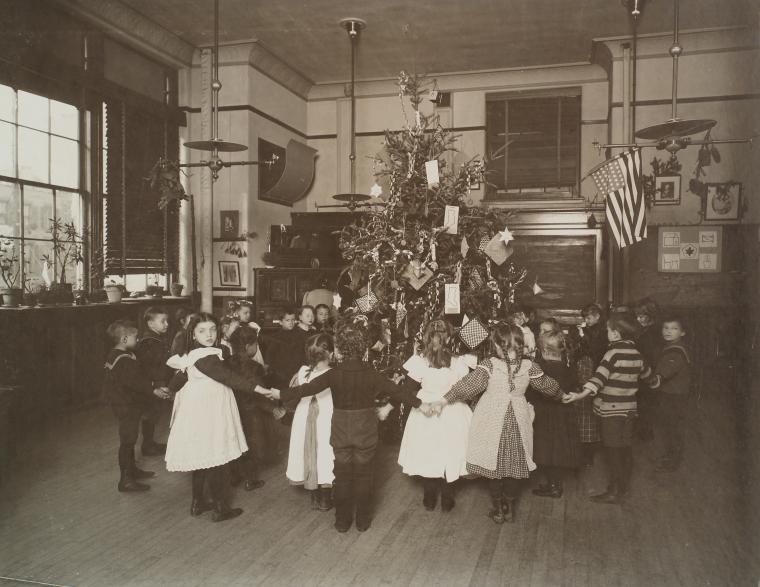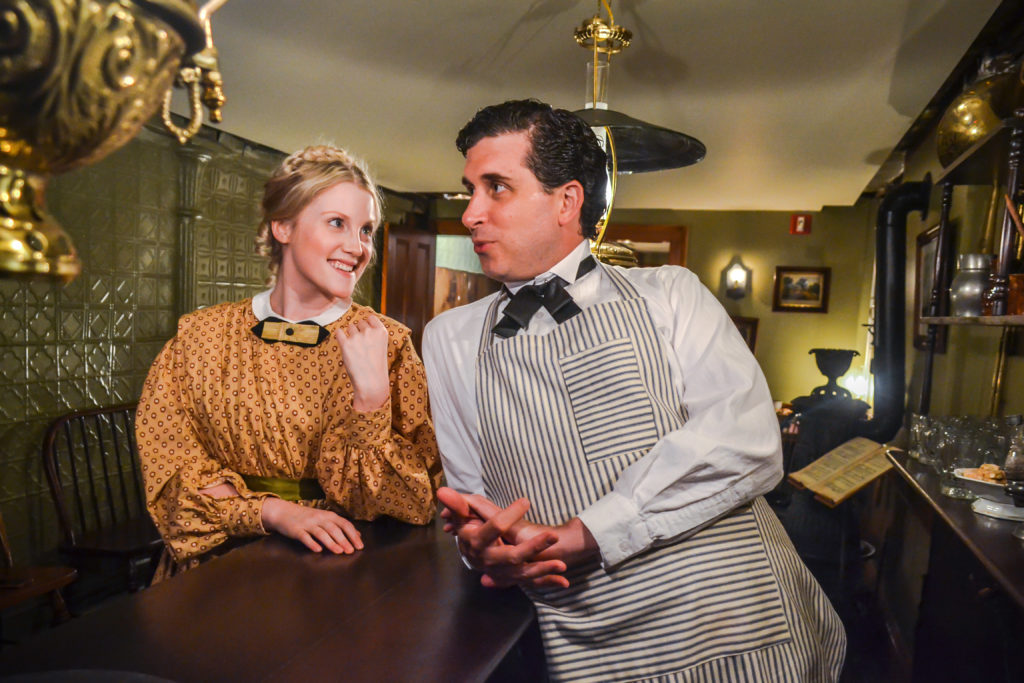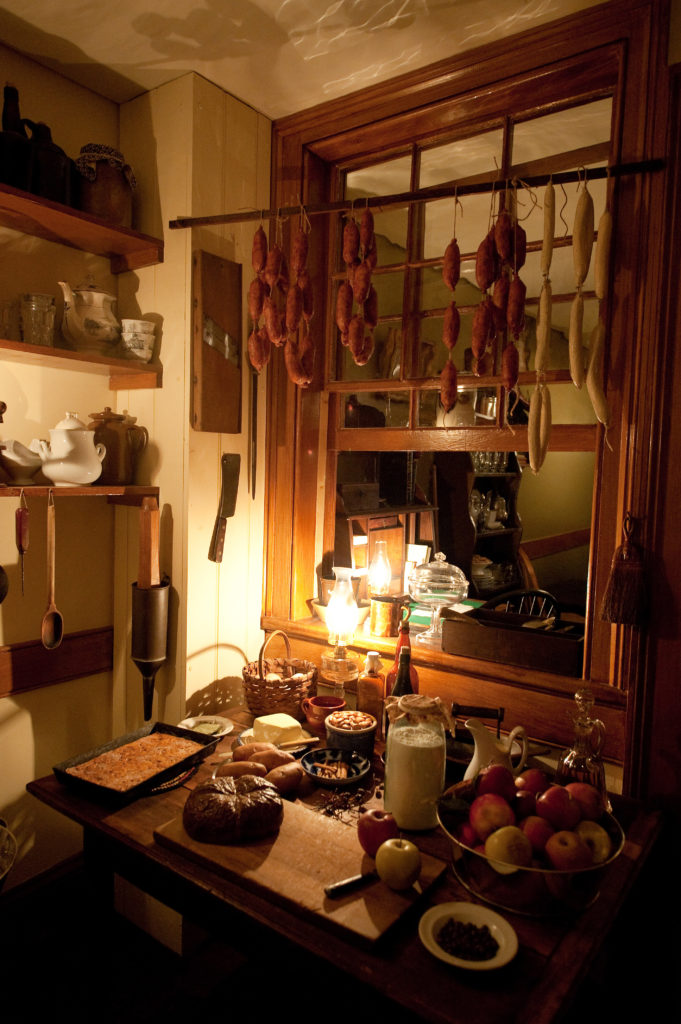Blog Archive
Our American Holiday: Saint Nicholas Day
What is the American holiday tradition? It might not be what you think it is. Or rather, it’s everything you think it is: if you live in this country and are celebrating this holiday season, your customs, celebrations, and beliefs are woven into the fabric of the American cultural tapestry. Throughout the month of December, we’ll be looking at these different customs – where they came from, how they’ve evolved, and how they’ve become integral to defining what we know as “Our American Holiday.”

Children around a Christmas tree. Courtesy of New York Public Library.
Today, on Saint Nicholas Day, we’re exploring the traditional American Christmas celebrations, many of which are actually a product of German immigrants – from spiced cookies and wine, to the ever-present, always-beautiful Christmas tree.
Imagine it’s evening on Orchard Street, December 1871, and though the streets, homes, and saloons of Kleindeutschland are crowded and noisy with people, the song that rings out into the cold is a newer German classic: “Stille Nacht.” Otherwise known as “Silent Night.”
We may not know exactly how John and Caroline Schneider, saloon owners discussed on our Shop Life tour, were celebrating that Christmas, but we can easily infer it was a festive night for them. The New York Times describes the revelries of Christmas Eve, 1871 as a joyous, busy affair, especially for business owners:
“Among the Germans Sunday was a busy day in making preparations for Christmas Eve, which is a German family and children’s festival. A feature of this is always the brilliantly illuminated Christmas tree, decorated with toys, confectionary, and holiday gifts for the young. As the weather was delightful yesterday, the principal thoroughfares on the east side, the Bowery, Division, Grand and Houston Streets, were crowded with persons, patronizing the shops where Holiday goods were retailed, which yesterday were kept open for the occasion. The places of amusement in the Bowery, the beer saloons and other public places, were decorated with Christmas trees, and many of these places were illuminated in the evening.”

Tenement Museum costumed interpreters portraying Caroline and John Schneider, on our Live! at the Tenement program “Last Call at Schneider’s Saloon.”
Christmas had only become a National Holiday the year before, but German immigrants like the Schneiders would have been celebrating every year, and their customs are now what we know as traditional Christmas features in America. Having a celebration on Christmas Eve in general was first part of the German festivities, as are holiday markets, letters to Santa, gingerbread houses, and, of course, the Christmas tree. Preparations for Christmas began even earlier than December 1 (so the next time someone tries to shame you for listening to Christmas music in November, inform them you are just partaking in a centuries-old German tradition.) The lead-up to Christmas is known as the Advent, which takes place throughout the month of December.
The most famous of these Advent days is St. Nicolas Day and is, as you might have guessed, the foundation for another Christmas tradition – Santa Claus. However, St. Nicolas visits the children of Austria, parts of Germany, and Switzerland on December 5th, not the 24th, and the holiday is seen as a preliminary to Christmas.
Still practiced in some areas today, children would place freshly polished boots in front of doors, under windows, or at the foot of their beds before heading to bed. Then, St. Nicolas would leave gifts – candy, nuts, and toys – inside the shoes to be found the next morning by well-behaved children. Unlike Santa Claus, though, St. Nicolas had a counterpart known as either Krampus or Knecht Ruprecht, who teased the badly-behaved kids with a switch, or gave them goal instead of presents.
 But while German children might have been more excited by St. Nicolas Day, Christmas Eve was the biggest of the celebrations. This is when families would exchange gifts (rather than on Christmas morning) and parents would reveal the beautifully decorated Christmas tree to the children. Outside the home, the religious would go sing carols and attend midnight Mass. Everyone else would go to the saloons.
But while German children might have been more excited by St. Nicolas Day, Christmas Eve was the biggest of the celebrations. This is when families would exchange gifts (rather than on Christmas morning) and parents would reveal the beautifully decorated Christmas tree to the children. Outside the home, the religious would go sing carols and attend midnight Mass. Everyone else would go to the saloons.
The Schneiders most likely decorated their saloon with a Christmas tree, and John, a talented musician, would have filled the warm bar with music and songs. Yes, German immigrants were likely the first to start “rockin’ around the Christmas tree.” John’s home region of Franconia is famous for its Lebkuchen, a tradition Christmas cookie that Caroline might have made for her customers to snack on year-round. And while the Schneiders typically just sold beer at their saloon, Caroline likely made Glühwein for the holidays. A delicious spiced wine served hot, Glühwein would have paired well with the Lebkuchen and all the other traditional German food that the Schneiders gave away for their free lunch.
Immigrating to a new country is always a trial, even when still surrounded by fellow countrymen like that in Little Germany. But with the holidays being a time to celebrate family, good will, and community, these cherished traditions are essential in making a new home feel like home. And likewise, over time, these rituals become adopted, and blended into their current landscape, creating what some might call “the new old-fashioned way.”
What is your American holiday tradition? Share it now on Your Story, Our Story!
- Post by Gemma Solomons, Marketing & Communications Coordinator at the Lower East Side Tenement Museum